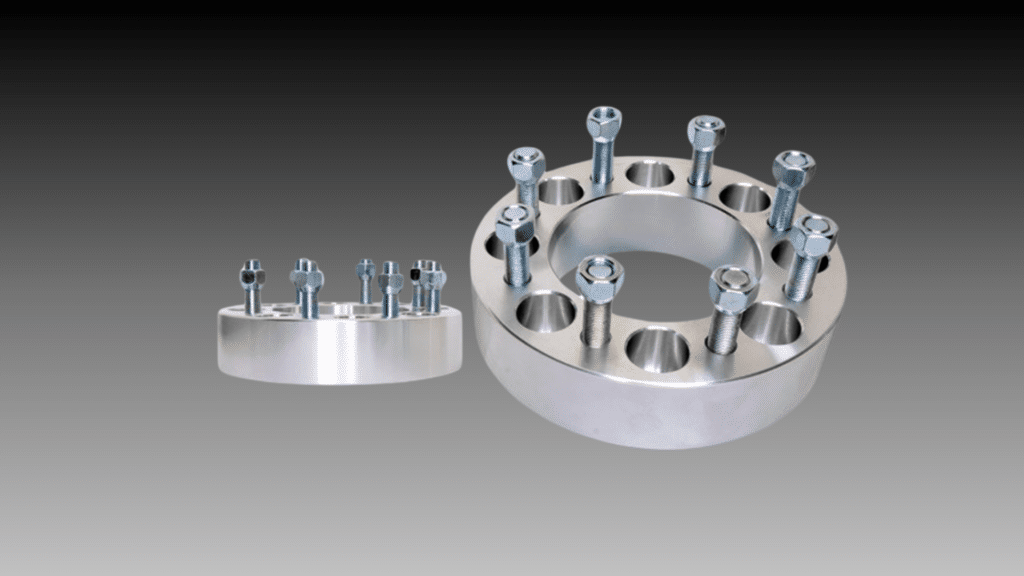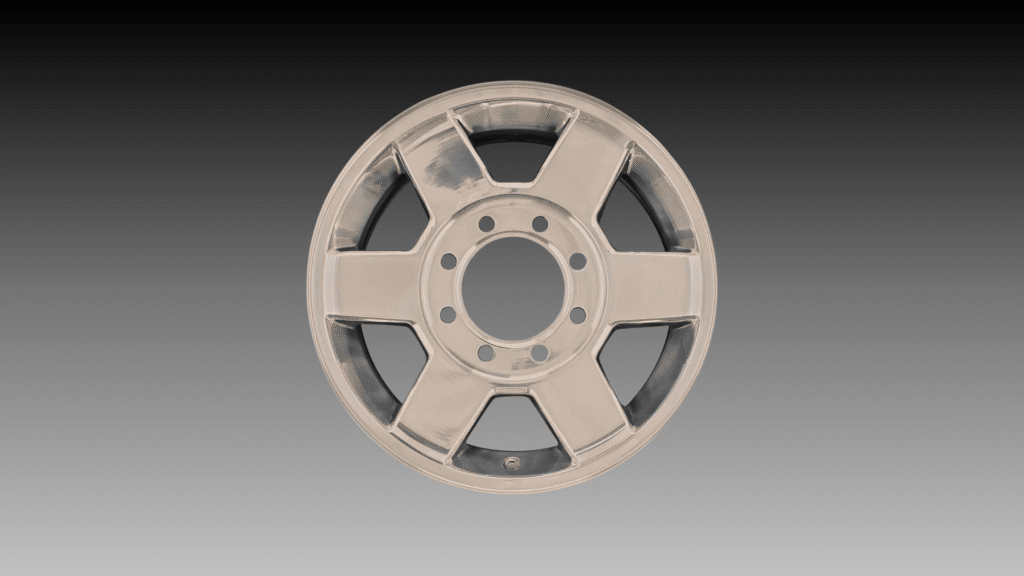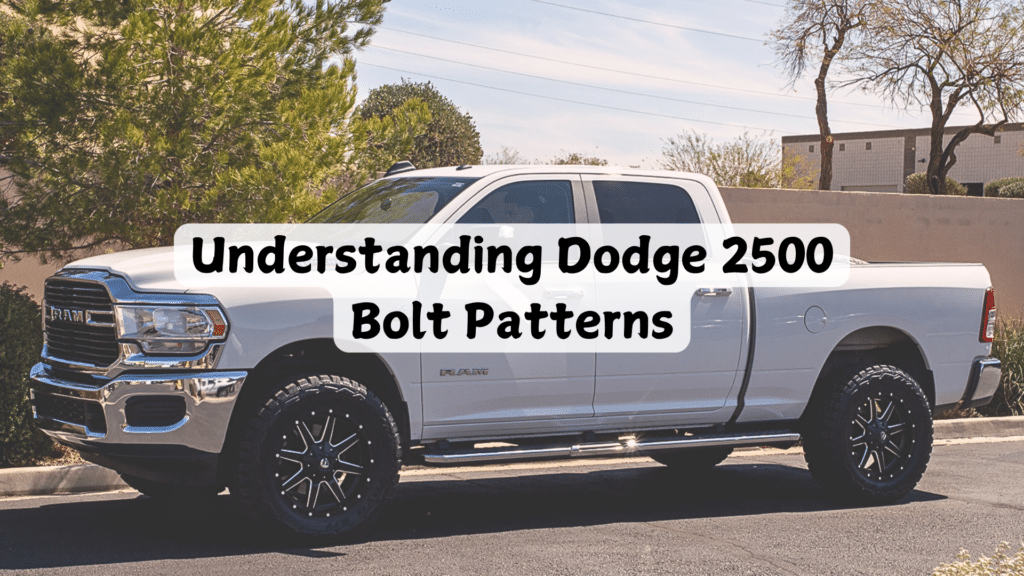Last month, I needed to replace the wheels on my Dodge 2500.
What seemed like a simple task turned into hours of research about bolt patterns.
I wish I had found clear information immediately – it would have saved me time and money.
In this article, I’ll share everything I learned about Dodge 2500 bolt patterns.
You’ll find out exactly what pattern fits your truck and how to measure it correctly.
I’ve owned three Dodge trucks over the past decade and worked as a mechanic for 15 years.
I’ve seen the costly mistakes people make when buying wheels that don’t fit.
By the end of this post, you’ll know:
- The correct bolt pattern for your specific model year
- How to measure your truck’s pattern accurately
- Which wheels are compatible with your 2500
Let me help you get this right the first time.
What Is the Bolt Pattern for a Dodge 2500?

Let me break this down in simple terms.
A bolt pattern shows two things: how many lug holes your wheel has and how far apart they are.
Think of it as a circle with points where the wheel attaches to your truck.
For Dodge 2500 trucks, the bolt pattern is 8 x 6.5 inches (or 8 x 165.1mm if you’re using metric).
Here’s what these numbers mean:
- The “8” tells you there are 8 lug holes
- The “6.5” shows the diameter in inches between opposite holes
Since 1994, this pattern has remained the same for most Dodge 2500s.
During my years working in the shop, I checked hundreds of trucks for this.
Want to double-check your truck’s pattern?
Measure from the center of one lug hole to the center of the hole directly across from it.
The distance should be 6.5 inches.
A quick tip: Don’t confuse this with the Dodge 1500’s pattern—they’re different.
If you get it wrong, your new wheels won’t fit.
Understanding Dodge 2500 Bolt Patterns and Their Compatibility
I’ve seen how bolt patterns affect wheel fit through my years working with trucks.
Let me share what I know about the Dodge 2500.
Model Year Changes
Most Dodge 2500s use the 8 x 6.5 inch pattern, but there’s more to the story.
Here’s what I found:
- 1981-1993 models: Used a 5-lug pattern
- 1994-present: Use the 8-lug pattern
- All Heavy Duty models: Stick with the 8-lug setup
Safety First
Putting the wrong wheels on your truck is risky. Here’s why:
- Wheels might shake at high speeds
- Extra stress on your wheel bearings
- Risk of wheels coming loose
- Brakes might not work right
I once had a customer ignore these warnings. His wheels wore out in just 6 months.
Beyond the Bolt Pattern
The bolt pattern isn’t the only thing to check. You also need to know about:
Hub Bore Size
- Centre hole must match your hub exactly
- Too small: Won’t fit
- Too big: Wheels will wobble
Wheel Offset
- This is how your wheel sits on the hub
- Wrong offset can cause:
- Rubbing against brake parts
- Stress on bearings
- Odd tire wear
Your truck’s warranty might not cover damage from wrong-sized wheels.
I always tell my customers to measure twice and buy once.
List of the Correct Bolt Pattern for Different Dodge 2500 Models
I’ve put together a clear list of bolt patterns by year. I double-checked these measurements to ensure you get the right fit for your truck.
1981-1993 Models
- Pattern: 5 x 5.5 inches
- Works with older-style wheels only
- Includes all trims
1994-2002 Models
- Pattern: 8 x 6.5 inches
- Fits both gas and diesel models
- Same pattern for all trim levels
2003-2012 Models
- Pattern: 8 x 6.5 inches
- Standard across all versions
- Includes Power Wagon edition
2013-Present Models
- Pattern: 8 x 6.5 inches
- Fits all current 2500 trucks
- Same for Limited and Laramie trims
Special Notes
Some things I learned from working on these trucks:
- The Power Wagon (all years) keeps the same 8 x 6.5 pattern
- SLT and Tradesman packages use standard patterns
- Aftermarket wheels must match these exact specs
Important: Always measure your specific truck. While rare, some dealers made special modifications that might affect wheel fit.
How to Identify the Correct Bolt Pattern for a Specific Dodge 2500 Model
Let me show you three ways to check your truck’s bolt pattern. I use these methods in my shop every day.
Method 1: Visual Check and Measurement
Basic Steps:
- Count the lug nuts on your wheel
- Take out one lug nut
- Measure from the middle of that hole to the middle of the hole across from it
- Write down both numbers
Example: If you count 8 lugs and measure 6.5 inches across, you have an 8 x 6.5 pattern.
Method 2: Check Your Papers
You can find your bolt pattern in these places:
- Owner’s manual (look in the wheels section)
- Driver’s door sticker
- Service records from your dealer
Method 3: Use the Right Tools
Here’s what I use to measure patterns:
- Bolt pattern gauge ($15-20 at parts stores)
- Digital calipers for exact numbers
- Paper template (I can show you how to make one)
Pro tip: Take a photo of your measurements. This helps when shopping for wheels.
Common Mistakes to Avoid
I see these errors all the time:
- Measuring from the wrong spots on the holes
- Using the wrong measuring tools
- Not writing down the numbers
- Trusting online listings without checking your truck
Remember: If you’re unsure, ask your local parts store to check. Most will do this for free.
Comparisons Between Dodge 2500’s and Other Brands’ Bolt Patterns
Let me break down how the Dodge 2500’s bolt pattern compares to other trucks.
I’ve worked on all these brands, and here’s what you need to know.
Quick Comparison Table
| Truck Brand & Model | Bolt Pattern | Does it match the Dodge 2500? | Notes |
|---|---|---|---|
| Dodge 2500 (1994-Present) | 8 x 6.5″ | — | Base pattern for comparison |
| Chevy/GMC 2500 (2011-Present) | 8 x 6.5″ | Yes | Wheels can often be swapped |
| Ford F-250 (1999-Present) | 8 x 6.7″ | No | Just a slightly bigger pattern |
| Older Chevy/GMC (Pre-2011) | 8 x 6.5″ | Yes | Full compatibility |
| Older Ford (Pre-1999) | 8 x 6.5″ | Yes | Rare but compatible |
What This Means For You
I created this simple list of facts about wheel swapping:
Will Work:
- Most Chevy/GMC 2500 wheels (2011-up)
- Older GM truck wheels
- Some aftermarket wheels made for multiple brands
Won’t Work:
- Modern Ford F-250 wheels
- Light-duty truck wheels
- Most import truck wheels
Remember: Even if the bolt pattern matches, check the wheel offset and hub size before buying.
How to Maintain Bolt Patterns on Your Dodge 2500

Let me share some tips I’ve learned from years of truck maintenance.
These steps will help keep your wheels secure and your bolt pattern in good shape.
Check Your Lug Nuts
I check my lug nuts every 3,000 miles. Here’s what you need to do:
- Get a torque wrench (borrow one from an auto parts store)
- Set it to 140 foot-pounds
- Tighten in a star pattern
- Listen for the “click” at the right tension
Warning: Loose lug nuts can ruin your wheel holes.
Keep Things Clean
Every time you take off a wheel:
- Clean the mounting surface
- Brush off any rust
- Wipe the lug nuts clean
- Check for damaged threads
I use a wire brush and WD-40 for stuck-on rust.
Smart Rotation Schedule
Mark your calendar for these checks:
- Rotate tires every 6,000-8,000 miles
- Check wheel balance at rotation
- Look for uneven wear patterns
- Make sure lug holes aren’t getting bigger
Quick Tip: If you hear rattling or feel wobbling, immediately check your wheels.
Extra Protection Steps
These tricks help prevent problems:
- Use anti-seize on lug nuts (just a tiny bit)
- Keep spare lug nuts in your truck
- Write down your torque settings
- Take photos of any damage you find
Remember: A little care now saves big repairs later.
Conclusion
Getting your Dodge 2500’s bolt pattern right matters more than most people think.
Through this guide, you’ve learned the basics: most 2500s since 1994 use an 8 x 6.5-inch pattern, but you should always check your specific model.
Personal note: When I put the wrong wheels on my first 2500, it cost me $800 to fix my mistake.
Now that I know better, I haven’t had a single-wheel problem in five years.
My final tips for you:
- Double-check your measurements
- Keep your lug nuts at the right torque
- Save your wheel specs in your phone
Got questions about your truck’s bolt pattern?
Leave a comment below, and I’ll help you figure it out.
Frequently Asked Questions
Can I Use My Dodge 2500 Wheels On A Ram 3500?
Yes, both trucks share the same 8 x 6.5-inch bolt pattern.
Just make sure the load rating of your wheels to ensure they match your 3500’s needs.
How Often Should I Retorque My Lug Nuts?
Check torque after installing new wheels and after 50-100 miles, then every 3,000 miles or three months during regular service.
What Happens If I Mix Different Wheel Sizes?
Mixing wheel sizes can damage your truck’s differential and cause handling problems.
Always use matching wheels on all positions.
Will 2WD Wheels Fit On A 4WD Dodge 2500?
Yes, the bolt patterns are the same.
However, check the wheel offset and backspacing, as 4WD models might need different clearances.
Why Are My Lug Nuts Hard To Remove?
Overtightening or rust can cause lug nuts to stick.
To prevent this, use an anti-seize compound and the proper torque specs.

